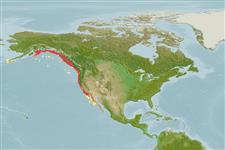Common names from other countries
>
Perciformes/Scorpaenoidei (Scorpionfishes) >
Sebastidae (Rockfishes, rockcods and thornyheads) > Sebastinae
Etymology: Sebastes: Greek, sebastes = august, venerable (Ref. 45335); diploproa: From the Greek diploos and prora, meaning 'double' and 'prow' (Ref. 27436).
More on author: Gilbert.
Environment: milieu / climate zone / depth range / distribution range
Ecologia
marinhas batidemersal; intervalo de profundidade 0 - 800 m (Ref. 6793), usually 91 - 579 m (Ref. 2850). Deep-water; 60°N - 27°N, 168°W - 109°W
Northeast Pacific: Alaska Peninsula to Cedros Island, Baja California and the Gulf of California in Mexico.
Length at first maturity / Tamanho / Peso / Idade
Maturity: Lm 19.0, range 18 - ? cm
Max length : 46.0 cm TL macho/indeterminado; (Ref. 4925); peso máx. Publicado: 810.00 g (Ref. 40637); Idade máx. registada: 86 anos (Ref. 56049)
Espinhos dorsais (total): 13; Raios dorsais moles (total): 11-14; Espinhos anais 3; Raios anais moles: 5 - 8; Vértebras: 26. Head spines strong - nasal, preocular, postocular, tympanic and parietal spines present, supraocular, coronal and nuchal spines absent (Ref. 27437). Toothed knob in front of each upper jaw, deep notch between jaws (Ref. 27437). Caudal fin moderately indented (Ref. 6885). A red rockfish, silver ventrally (Ref. 27437). Branchiostegal rays: 7 (Ref. 36715).
Common offshore, on soft bottoms (Ref. 2850). Young occur in shallow water, often at surface under drifting kelp (Ref. 2850). Viviparous, with planktonic larvae and pelagic juveniles (Ref. 36715, 34817). The biggest individuals are sometimes found in markets where the flesh is sold as rockfish fillet (Ref. 27436). Rarely caught by anglers (Ref. 27436).)
Gives birth in spring (Ref. 27436).
Eschmeyer, W.N., E.S. Herald and H. Hammann, 1983. A field guide to Pacific coast fishes of North America. Boston (MA, USA): Houghton Mifflin Company. xii+336 p. (Ref. 2850)
Categoria na Lista Vermelha da IUCN (Ref. 130435)
CITES (Ref. 128078)
Not Evaluated
Ameaça para o homem
Harmless
Utilização humana
Pescarias: pouco comercial
Mais informação
ReferênciasAquaculturaPerfil para aquaculturaEstirpesGenéticaElectrophoresesHereditariedadeDoençasProcessamentoMass conversion
ColaboradoresFotografiasStamps, Coins Misc.SonsCiguateraVelocidadeTipo de nataçãoÁrea branquialOutras referênciasCérebrosVisão
Ferramentas
Relatórios especiais
Descarregue XML
Fontes da internet
Estimates based on models
Preferred temperature (Ref.
115969): 4.4 - 8.6, mean 5.9 (based on 131 cells).
Phylogenetic diversity index (Ref.
82804): PD
50 = 0.5000 [Uniqueness, from 0.5 = low to 2.0 = high].
Bayesian length-weight: a=0.01000 (0.00499 - 0.02004), b=3.09 (2.92 - 3.26), in cm Total Length, based on LWR estimates for this Genus-body shape (Ref.
93245).
Nível Trófico (Ref.
69278): 3.5 ±0.39 se; based on food items.
Resiliência (Ref.
120179): Baixo, tempo mínimo de duplicação da população 4,5 - 14 anos (tm=5; tmax=86; Fec=14,000).
Fishing Vulnerability (Ref.
59153): Moderate vulnerability (36 of 100).
